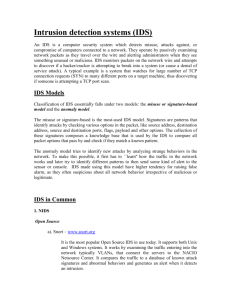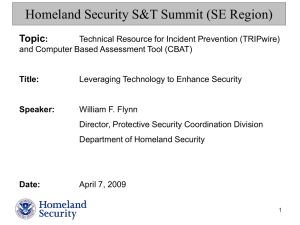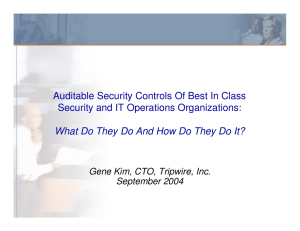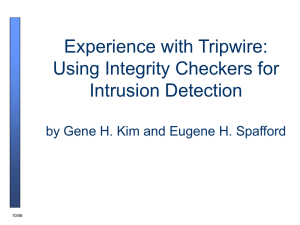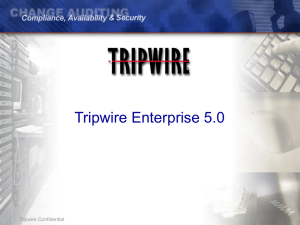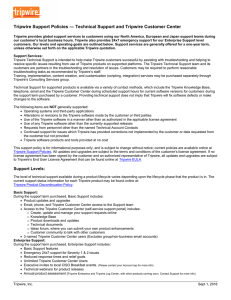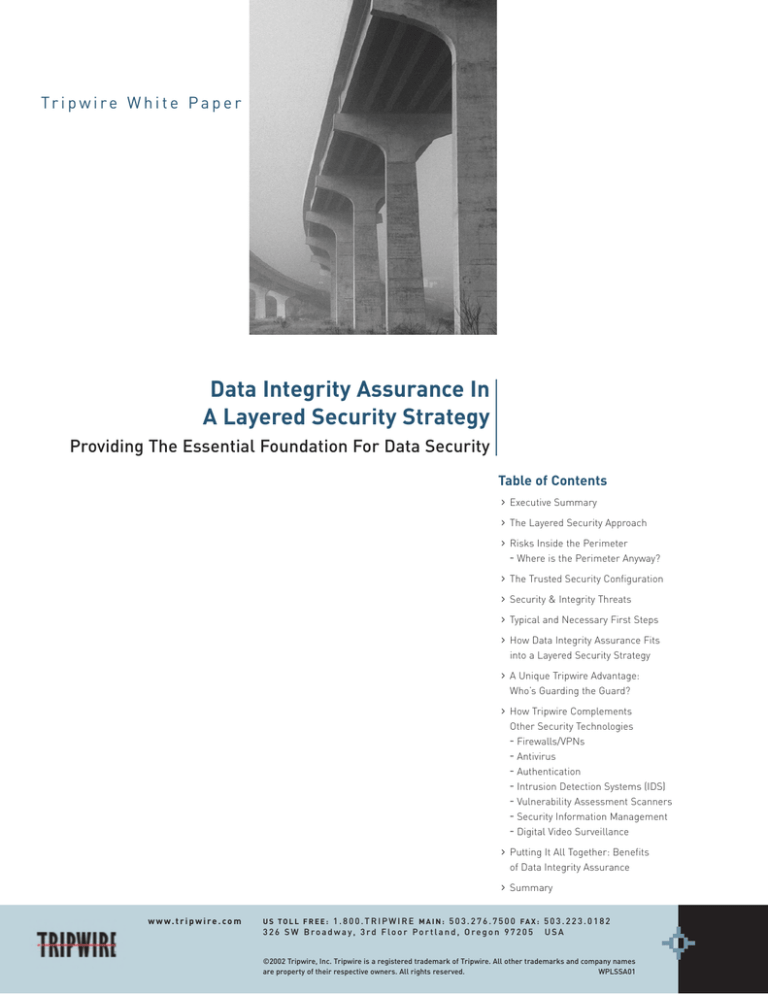
Tr i p w i re W h i t e P a p e r
Data Integrity Assurance In
A Layered Security Strategy
Providing The Essential Foundation For Data Security
Table of Contents
> Executive Summary
> The Layered Security Approach
> Risks Inside the Perimeter
– Where is the Perimeter Anyway?
> The Trusted Security Configuration
> Security & Integrity Threats
> Typical and Necessary First Steps
> How Data Integrity Assurance Fits
into a Layered Security Strategy
> A Unique Tripwire Advantage:
Who’s Guarding the Guard?
> How Tripwire Complements
Other Security Technologies
– Firewalls/VPNs
– Antivirus
– Authentication
– Intrusion Detection Systems (IDS)
– Vulnerability Assessment Scanners
– Security Information Management
– Digital Video Surveillance
> Putting It All Together: Benefits
of Data Integrity Assurance
> Summary
w w w. t r i p w i re . co m
U S T O L L F R E E : 1 . 8 0 0 . T R I P W I R E M A I N : 5 0 3 . 2 7 6 . 7 5 0 0 FA X : 5 0 3 . 2 2 3 . 0 1 8 2
326 SW Broadway, 3rd Floor Portland, Oregon 97205
USA
©2002 Tripwire, Inc. Tripwire is a registered trademark of Tripwire. All other trademarks and company names
are property of their respective owners. All rights reserved.
WPLSSA01
Executive
Summary
Much of the attention commanded by computer security issues focuses on threats from external sources.
Firewalls and perimeter defense tools are deployed to deny unauthorized entry to the network. Experts
look for vulnerabilities and ways to ensure that the perimeter cannot be breached. Administrators monitor
network traffic for unusual activities and anomalies. It is common for users to be warned against suspicious email attachments. The assumption is that malicious intrusions and threats come from external
sources. In other words, the focus is on protecting the enterprise from an outside attack.
While all of these measures are valuable and should be deployed to help protect digital assets, none of
these technologies protects companies from data loss or damage that occurs from inside the network—
whether it be accidental or malicious in nature. None lets you know when your best perimeter defenses
and network security policies have been compromised. None are able to establish a “good,” desired state
of data and enable quick restoration if an undesired change occurs.
This paper will describe the elements you should consider in implementing a comprehensive security
strategy and tell you why no security strategy is complete without data integrity assurance, why it is the
cornerstone for safeguarding your data assets, and how it works alongside other perimeter defense
products to ensure maximum protection for your enterprise.
The Layered
Security
Approach
A complete security strategy should be layered, which can be likened to fully securing a house. For
example, you can lock your doors and windows and turn on alarms, but if you’ve accidentally knocked a
hole in the wall or are hosting a guest who secretly causes problems once inside, locks and alarms alone
won’t adequately protect you.
A layered approach to security will include protecting from outside attackers, internal breaches of security
and mishaps caused by both innocent and malicious people on the inside. There are several elements to a
layered security strategy that assist in addressing the three elements of trusted security configuration
(integrity, availability, and confidentiality). Layered security strategies typically contain all or most of the
following items:
>> Security Policy
>> Incident Response Plan
>> Host System Security
>> Auditing
>> Intrusion Detection Systems
>> Router Security
>> Firewalls
>> Vulnerability Assessment
Internet
External
Attacks
Firewall and
Antivirus
Missed Attacks
and Internal Misuse
Network and
Host IDs
Internal Accidents
and Changes
Vulnerability Scanners
and Security Policy
Enforcement
Data Integrity
Assurance
Figure 1 – This diagram illustrates that many perimeter defense tools miss many of the threats to a
data system’s integrity state.
Risks Inside
the Perimeter
No matter what type of business you are in, computers and digital assets are an integral part of your
operations. Protecting your computer systems, computer operations, and information assets against loss
may be your business’s most critical form of digital asset protection.
What is overlooked in many security strategies is the integrity of the “foundation” upon which the critical
IT infrastructure is built. Due to the complexities of IT software, it is becoming much more difficult to
know for sure what constitutes a clean start or baseline state for client, server, network devices, database
management systems, and applications.
For example, one IT manager for a service provider interviewed by IDC stated that a vendor’s UNIX server
software contained 30,000 files per install. Even after removing files that were not required for the specific
task, 16,000 files still remained. What if any of these files is altered, either by a disgruntled employee or
innocently by an unaware employee?1
1
IDC white paper, “Data and Network Integrity: Technology to Invoke Trust in IT”,
01-104SYSTEM2930, May 2001.
Where is the Perimeter Anyway?
It’s no longer easy to determine where the perimeter is in today’s environment of distributed technology.
VPNs, extranets, tunneling and simply the many technical possibilities of e-commerce and the Web make
it virtually impossible to support a truly contained network with a clear “outside” and “inside.”
That’s why the original idea of a “secure” perimeter is no longer enough. The original security architects
were government agencies and defense contractors who were experts in handling confidential assets.
Their training led them to lean toward perimeter defenses as the cornerstone of defense. Even though
baseline data integrity was recognized as one of the four pillars of conventional security, it was presumed
that as long as the perimeter was secure, assets were automatically secure.The architects reasoned that
IT assets didn’t need to be monitored or managed for integrity, because the command and control
environment gave people assurance that core data was safe.
Today, the situation is different. Any network with an Internet connection is by default an open network.
One large financial institution articulated it this way, “Perimeter defense based on firewalls is still
important, but more sophisticated security systems are needed because we don’t even know where
the perimeter is anymore.”
“Integrity drift” refers to another kind of risk to data integrity that cannot be stopped at the perimeter. It
describes movement away from a desired state. Integrity drift is the result of several factors, including the
diversity of platforms, applications and processes operating in any typical IT organization; the complexity
introduced by mergers and acquisitions; and the ongoing pressure on IT by business users to “just get it
up and running quickly.”
One company’s information security executive related that when he came on board, his organization had
200+ machines on the Internet, each one configured differently from the rest. The machines that were
created with variations also were not properly maintained. The company had a lot of operations staff
focused on deployment, but there were no system administrator resources to maintain the machines.
The CIO described the feeling of his lack of control of the assets by stating that, “when I joined, it was
clear that, well, the machines weren’t really ours anymore.” 2
The Trusted
Security
Configuration
Shifting perimeters, internal threats, and integrity drift: These are all facets of security not addressed by
the defenses most typically associated with computer security. The omission becomes more apparent
when one revisits the goals which drive recommendations behind modern security measures:
1. Availability (of systems and data for intended use only)
Availability is a requirement intended to assure that systems work promptly and service is not denied
to authorized users. This objective protects against:
>> Intentional or accidental attempts to either:
– perform unauthorized deletion of data or
– otherwise cause a denial of service or data.
>> Attempts to use system or data for unauthorized purposes
2
Ibid.
2. Integrity (of system and data)
Integrity has two facets:
>> Data integrity—the property that data has not been altered in an unauthorized manner while
in storage, during processing, or while in transit, or
>> System integrity—the quality that a system has when performing the intended function in
an unimpaired manner, free from unauthorized manipulation.
3. Confidentiality (of data and system information)
Confidentiality is the requirement that private or confidential information not be disclosed to unauthorized
individuals. Confidentiality protection applies to data in storage, during processing, and while in transit.
The ultimate goals of any security strategy are threefold: availability, confidentiality and integrity of the
data and systems.Tripwire data integrity assurance is the cornerstone.
Confidentiality
Trusted Security
Configuration
Availability
Integrity
Figure 2 – Trusted Security Configuration Model
Security &
Integrity
Threats
Deploying a layered security solution will help protect organizations from the many security
challenges that exist today. Security challenges fall into several broad categories:
>> System misconfiguration
>> Internal users
>> External threats
>> Lax security policies and processes
>> Experimentation and inadvertent errors
Businesses must address each of these broad challenges to prevail. Connecting to the Internet, essentially
connects the business to the public networks of the entire world, thus exposing business infrastructures
to the possibility of exploitation by thousands of people in the outside, online, global community. The key
points for consideration when reviewing your security standing are:
>> System Misconfiguration: A recent analyst report indicates that more than 65% of security vulnerabilities in an organization are as a result of system misconfiguration. These include (but are not
limited to) updating systems with the latest vendor-released security fixes and periodic review of
risks and policies resulting from changes in services and/or service levels offered. Strong security
requires operational diligence, driven by the requirements of policy and processes and a clear
understanding of the underlying business risks that the organization takes when not adhering to
the policies/processes.
>> Internal Users: Threats from internal users can be classified as either malicious or inadvertent/
experimentation. The former is a conscious and intentional attack on the system infrastructure to
compromise services or information. Of 239 companies polled by the FBI in March 2000, 71%
reported unauthorized access to systems by insiders.
The latter is a result of well-meaning employees who can cause severe service outage or information
compromise as a result of inadvertent or ill-advised actions. Indeed ‘experimentation’ is one of the
most common reasons for system outages and has a direct bearing on system misconfiguration. It
is also a result of failure to employ policy and the appropriate technology related to change control.
>> External Threats: A lesser, but perhaps more potentially embarrassing threat to your business
comes from outside; viruses, worms, denial of service, web-defacement, and hacker penetration
from the Internet can lead to downtime and loss of reputation and business, especially if publicized in the popular media.
>> Security Policy: An effective security policy will EXPLICITLY make clear the risks that a business
has foreseen and how they must address them, while also setting IMPLICIT standards of practice
that must be adhered to. We raise the issue of security policy here because policy ITSELF must be
created first of all, and it must address the following matters of misconduct, hacking, etc.
>> Theft: A matter often not considered is simply one of physical security. All computers (and their
components) are valuable physical assets, ripe for theft. Theft leads to downtime, embarrassment,
loss of business, and leakage of proprietary information.
>> Fraud: At least two fraud-related risks impact e-commerce businesses and must be addressed:
bogus payment, and liability due to theft of customer payment data, such as credit-card details.
>> Proprietary Information: Your data is your lifeblood. Threats come from physical theft, accidental
deletion or destruction (fire, flood)—or more insidiously perhaps from non-destructive copying,
leaving no trace of the theft.
>> Human Error: This is perhaps the broadest yet mildest form of threat; lack of security awareness
amongst employees can lead to leakage of proprietary data through personal emails, being
locked-out of network resources through loss/forgetting of passwords, and vulnerability to
con-artists and “social engineering.”
With data at the heart of today’s business, a company’s ability to compete and survive depends upon the
integrity of its IT infrastructure. And that infrastructure is increasingly vulnerable to unintentional misuse
and malicious attacks.
Typical and
Necessary First
Steps
When managers and security professionals
consider implementing a security strategy,
typically they implement an Intrusion Detection
System (IDS) as the key first step: that’s because
executives and shareholders alike want to keep
all the ‘bad-guys’ out. But who and where are
the bad guys?
A complete intrusion detection system (IDS)
must consist of three key components: firewalls,
network intrusion detection, and data integrity
assurance tools. However, while firewalls
impose a barrier at the point of connection
between the Internet and the protected network,
A Unique Tripwire Advantage:
Who’s Guarding the Guard?
One of the primary applications of Tripwire
software is to monitor the integrity of other
security products such as firewalls, intrusion
detection systems and anti-virus scanners. One
of the first things attackers try to do is disable
the security tools on the servers that they are
attacking.
and real-time network intrusion technologies
In some cases, a small change to a firewall might
are an effective second line of defense, neither
have a dramatic impact. For example, a change
address internal system misuse.
to the firewall configuration settings might be
A complete enterprise security solution requires
tools that can be quickly deployed and enable a
security administrator to rapidly identify malicious
or unwanted attacks. When combining layers of
defense, these elements work together to form
changed to either open up or shut down ports.
If an attacker can change a firewall rule to allow
them to open a port, then that would allow the
attacker to gain access through the firewall to
other more critical servers or targets.
a resilient barrier to unauthorized intrusions
Some security products have configuration files
and malicious attacks while complementing
that are stored in plain text that control how the
other security solutions such as authentication
product operates and functions. It is important
and encryption systems.
to monitor these files in order to detect any
Whenever network security is compromised,
whether due to a new worm attack or an
intrusion from an inside source, the integrity
of company data is in question. Many e-mail
unauthorized changes that may allow an
attacker to subvert the tool. Tripwire software
can easily be configured to monitor these
specific configuration files.
viruses modify or remove files from PC users’
Other files to monitor are the binary files of
disk drives; successful attacks against Web
security products in order to verify that no new
sites deface their content; and root kits modify
possible malicious binary versions of the product
system executables with ones that completely
are replaced. Tripwire for Servers uses cryptog-
cover an intruder’s tracks.
raphy (El Gamal) and encryption (3DES & SSL) to
These business assets are too valuable to be left
open to compromise, which is where Tripwire®
data integrity assurance solutions come into play.
protect its configuration and database files to
prevent any tampering. These are included in the
default policy file which ships with the product—in
essence, Tripwire technology helps guard Tripwire
products themselves, so you are assured that they
cannot be subverted without your knowledge.
Continued on next page.
How Data
Integrity
Assurance Fits
into a Layered
Security
Strategy
Trust in the network begins with the certainty
that you’re starting from a known good state.
Data integrity assurance software, such as
Tripwire for Servers and Tripwire for Network
Devices, establishes the baseline by taking a
‘snapshot’ of data in its desired state. It detects
and reports changes to the baseline, whether
A Unique Tripwire Advantage:
Who’s Guarding the Guard?
Continued
accidental or malicious, from outside or within.
By immediately detecting changes from the
Unlike firewalls, the Tripwire approach is not
baseline, Tripwire software can trigger fast
focused on the prevention of unauthorized
remediation, and avoid the necessity of having
access. Instead, it monitors data at rest and
to rebuild servers or routers from scratch.
identifies data changes, and then alerts the
system manager to unauthorized changes
In this way Tripwire software provides the
or internal or external intrusions. This is an
foundation for data security and ensures a
extremely important security function as many
safe, productive, stable IT environment. Tripwire
intentional and unintentional unauthorized
software detects change, whether accidental or
changes on data at rest take place from within
malicious, from outside or within, and is the only
an organization, or inside a firewall.
way you can know for certain that your data is
safe and your systems remain uncompromised.
There are many types of security tools that do
Tripwire software is used for: intrusion detection,
many different jobs, but it is important that these
file integrity assessment, damage discovery,
applications are also being monitored to allow for
change/configuration management, system
immediate notification and remediation of events
auditing, and policy compliance.
that could potentially allow for an attacker to
penetrate your network infrastructure. Tripwire
software is used in many cases to complete a
well-rounded security policy complementing
other security tools that may lack integrity
verification functionality. In fact, determining
the integrity of a system is one of the key components of having a solid security foundation.
How Tripwire
Complements
Other Security
Technologies
There are many data security technologies that a company can deploy that accomplish different goals.
Many of these technologies complete specific security objectives and functions and play a key role in
building a layered security strategy.
How Data Integrity Assurance
Software is Deployed with
Other Security Products
DIA
NVA
N
Router
DIA
NVA
N
TFA
SPI
H
DIA
NVA
HVA
AV
Mail Server
Internet
Router
Firewall
DIA
NVA
HVA
H
N
SIM
Operation
Center
TFA
SPI
H
TFA
SPI
H
HVA
Host Vulnerability Assessment: Host-based scanners provide
comprehensive views of hosts' operating systems, identifying risky
applications and user activities, configuration of specific services, and
detection of signs that an intruder has infiltrated a host or is still active on a
system.
DIA
NVA
HVA
AV
DIA
HVA
SPI
Workstation
DIA
NVA
HVA
AV
Modem
Internet
DNS Server
NVA
Network Vulnerability Assessment: Network-based scanners
provide comprehensive views of all operating systems and services running
and available on the network, detailed listings of all system-user accounts
that can be discovered from standard network resources, and discover
unknown or unauthorized devices on a network.
Workstation
Web Server
DIA
Data Integrity Assurance Solutions: Located on any system or
network device to monitor the integrity of critical files. These products do not
rely on a database of known attack signatures—additions, deletions or
changes to a file system are always detected.
DIA
HVA
SPI
TFA
SPI
H
DIA
NVA
HVA
AV
Application
Server
AV
Anti-Virus Scanners: Provide the ability to block viruses from getting
to servers or workstations. These products should be deployed to prevent
virus attacks from deleting and changing files. Many AV products use a
signature database to scan against to detect viruses. Often time new viruses
will not be in the database until it can be updated, which leaves a system
vulnerable.
TFA
Two Factor Authentication: Provides the ability to verify that
someone who is trying to access a system is actually authorized to access
the system. The most common form of authentication is the use of logon
passwords, the weakness of which is that passwords can often be forgotten,
stolen or accidentally revealed. Often times passwords will be combined with
tokens to provide two-factor authentication.
SIM
Security Information Management: Enables users to consolidate
security reports and information from many different security products to
correlate and provide actionable data.
SPI
Security Policy Implementation: Enables
SPImangers to automate each step of the security
security
policy from a central console. These tools enforce
awareness and assess employee understanding of
security policies
H
Host-Based Intrusion Detection Systems:
Monitor system or application logs for evidence of attack,
based on a database of attack signatures.
N
Network-Based Intrusion Detection Systems:
Examine network packets for suspicious patterns, based
on a database of attack signatures.
Figure 3 – This network diagram illustrates where Tripwire software should be deployed along with other
security products to build a layered security defense
Firewalls/VPNs
A firewall is a system or group of systems that enforces an access control policy between two networks.
Some firewalls place a greater emphasis on blocking traffic, while others emphasize permitting traffic.
It’s also important to recognize that the firewall’s configuration, because it is a mechanism for enforcing
policy, imposes its policy on everything behind it. Usually, a firewall’s purpose is to keep intruders out of
your network while still letting you get your job done.
Tripwire software data integrity assurance complements these firewalls as part of a layered security strategy:
>> Tripwire software will detect intruders from both within and from the outside where most damaged
is caused.
>> Firewalls can’t protect against attacks that don’t go through the firewall.
>> Tripwire software can operate on many types of servers monitoring all changes.
>> Tripwire software can be used to monitor and detect changes to firewall configuration changes
as well as exploitable operating systems.
>> Firewalls are deployed to detect and protect from known vulnerabilities.
>> Tripwire software will detect changes based on both known and unknown vulnerabilities.
Virtual private networks (VPNs) allow remote employees, partners and customers to securely access a
corporate network by establishing an authenticated, secure connection. These solutions certainly must be
deployed as part of a layered security strategy. Other security products, such as data integrity assurance,
will augment VPN security by verifying system and data integrity and changes that would be made by
authorized individuals who have an authorized and secure VPN connection.
Antivirus
Antivirus companies have made virus protection the best known defense against network invasion.
Certainly, no layered security strategy is complete without it. However, virus protection software works
primarily by looking for known virus signatures, coming from the outside in. That’s why virus definitions
must continually be updated—the software won’t find what it hasn’t been told to look for. Nor does it
bother to report file changes not associated with virus signatures.
Tripwire software is complementary to antivirus solutions because if a virus goes undetected from an
antivirus solution, Tripwire software can be used to assist in system or file recovery. For example, many
worm viruses change or delete Windows Registry values that would be nearly impossible to detect if a
user didn’t know which entry changed. But with Tripwire for Servers, a user can quickly detect exactly
which registry entry was changed or deleted and replace only those files that were affected.
Authentication
Authentication is the process of determining whether something or someone is who or what it has
declared it is. The most common form of authentication is the use of logon passwords, the weakness of
which is that passwords can often be forgotten, stolen or accidentally revealed. Often times passwords will
be combined with tokens to provide two-factor authentication. Users who need access must identify both
elements (token and password) in order to be authenticated.
Tripwire software is complementary to all forms of authentication because it can identify any changes to
a machine if the authentication method has been compromised. For example, suppose an attacker has
obtained both the token and password from a person who legitimately has the right to access a machine
and gets access to a machine or server to plant a backdoor (software that allows a hacker to continue to
have access to a machine without being detected). After the attacker has planted the backdoor, he returns
the token to the person he had stolen it from. At this point, no one knows that this attacker has had
access to the server, but later the attacker comes back to compromise and steal critical company files.
Tripwire software would provide two things here. First, it would identify that additional files (backdoors)
have been installed on the server in a hidden directory. The administrator can quickly delete this file(s)
which will not allow the attacker back into the system. Secondly, Tripwire software will identify the
company files that were tampered with, so that measures can be made to recover or restore those files.
No authentication product can provide this ability to recover from a breach.
Intrusion Detection Systems (IDS)
There are two primary kinds of intrusion detection systems:
>> Host based – Software that monitors a system or application log files. It responds with an alarm or
a countermeasure when a user attempts to gain access to unauthorized data, files or services.
>> Network based – Monitors network traffic and responds with an alarm when it identifies a traffic
pattern as either a scanning attempt or a denial of service or other attack.
Intrusion detection, again, is a vital facet of layered security. However, it will not tell you how data has been
compromised, what’s changed on your system, or what your data baseline was before the attack. Moreover,
IDSes do not look for internal threats, either malicious or due to employee error. Only data integrity assurance software monitors data itself for change, whether initiated internally or externally, regardless of the
cause or motive.
Firewalls, intrusion detection and anti-virus scanning systems are all quite effective against identified
attacks. Such ‘tried and true’ techniques continue to be employed by hackers simply because so many
companies have failed to implement these basic defenses. Of course, the industry’s best and brightest
hackers are constantly coming up with new and innovative ways to penetrate network resources. And
when they do, the vendors who supply firewall, IDS and anti-virus technologies upgrade their solutions.
But what happens if your network is one of the first to experience a new form of attack? Or what if there
is a defense against an attack, but you haven’t yet patched it into your network? How can you protect
yourself against what we cannot predict?
Vulnerability Assessment Scanners
These tools check the settings on systems to determine whether they are consistent with corporate
security policies and if they identify “holes” or vulnerabilities that attackers could exploit. Many products
simulate the behavior of attackers to learn which of as many as 600 possible weaknesses possibly present
on a system could get attacked.
Security Information Management
These products provide a very useful function. They centrally manage security data from other security
products to provide analysis and correlation of attack patterns across a network. They enable users to
interpret the vast amount of security data from multiple products into usable and actionable data that can
be responded to. A security product is only of value if the user can use and understand the information
that other security products provide. SIMs try to assimilate information to make it easier for users to
understand. These products are a component of a layered security solution because they can provide a
higher level view of a company.
Digital Video Surveillance
One often neglected part of a layered security solution is digital video surveillance that physically watches
servers, network devices or data centers. Integrating digital video surveillance security with data security
measures provides a well rounded approach at protecting a company’s critical IT infrastructure. Some
video surveillance solutions can send images electronically over a wired or wireless network to centralize
all computer security monitoring.
Putting It All
Together:
Benefits of Data
Integrity
Assurance
Tripwire software for servers, firewalls, routers, and switches helps companies build a foundation of
security by providing them a way to quickly detect accidental or malicious changes to data and quickly
recover to a desired good state. In combination with other security technologies, Tripwire software
provides companies the assurance that their digital assets are being monitored and protected.
Tripwire software provides the following benefits when deployed to detect data integrity changes:
>> Establishes a Foundation for Data Security – Tripwire takes a snapshot of data in its known, good
state, providing companies with a good starting point to monitor against. This snapshot allows
companies to verify that changes exist from the last known, good snapshot. This integrity assurance provides a critical component in establishing and maintaining data security.
>> Lowers Costs – Using Tripwire software will help lower costs associated with troubleshooting,
downtime or change management. Instead of wasting precious time looking for individual files
that have been tampered with or attempting to troubleshoot a system error, you can use Tripwire
software to quickly detect the change and allow you to get back to business. Time spent discovering the source of system problems is reduced from hours—sometimes days—to just minutes,
freeing up valuable IT resources for more proactive, productive activities.
>> Maximizes System Uptime – Tripwire software enables companies to maximize their investments
in IT by eliminating risk and uncertainty, while maximizing system uptime. Tripwire software
pinpoints the exact location and nature of change to enable quick restoration of systems to a
desired, good state. This reduces down time and maximizes uptime.
>> Increased Control and Stability – By verifying system integrity and limiting integrity drift users
gain more control over systems by knowing unequivocally whether a system has drifted from a
known good state.
Summary
There are many security practices that companies should implement in order to develop and deploy a
layered security solution that prevents, detects and responds to security incidents. Developing a robust
layered security strategy requires companies to consider complementary solutions that can address
attacks and breaches from the outside and the inside. In today’s environment, organizations connected
to the Internet must be more vigilant than ever. Networks are scanned for vulnerabilities many times a
day. Viruses and worms abound. And the threat of cyber terrorism looms. It takes a comprehensive well
thought-out strategy to protect against all of these problems.
By utilizing Tripwire software companies will not only mitigate security threats, but also create a more
stable IT environment. By detecting unauthorized changes, companies can proactively increase the
effectiveness of their change control and configuration management. Computer security is in many ways
similar to physical security in that no single technology serves all needs—rather, a layered defense is
proven to deliver the best results.
Tripwire software provides the fundamental security layer that provides a high degree of confidence in the
integrity of data assets and system infrastructure. This foundation provides the means to detect and understand changes to systems and data over time, and better enforce the security and availability of those assets.
As a result, companies and their customers are able to maintain trust in their network and IT infrastructure.
w w w. t r i p w i re . co m
U S T O L L F R E E : 1 . 8 0 0 . T R I P W I R E M A I N : 5 0 3 . 2 7 6 . 7 5 0 0 FA X : 5 0 3 . 2 2 3 . 0 1 8 2
326 SW Broadway, 3rd Floor Portland, Oregon 97205
USA
©2002 Tripwire, Inc. Tripwire is a registered trademark of Tripwire. All other trademarks and company names
are property of their respective owners. All rights reserved.
WPLSSA01


